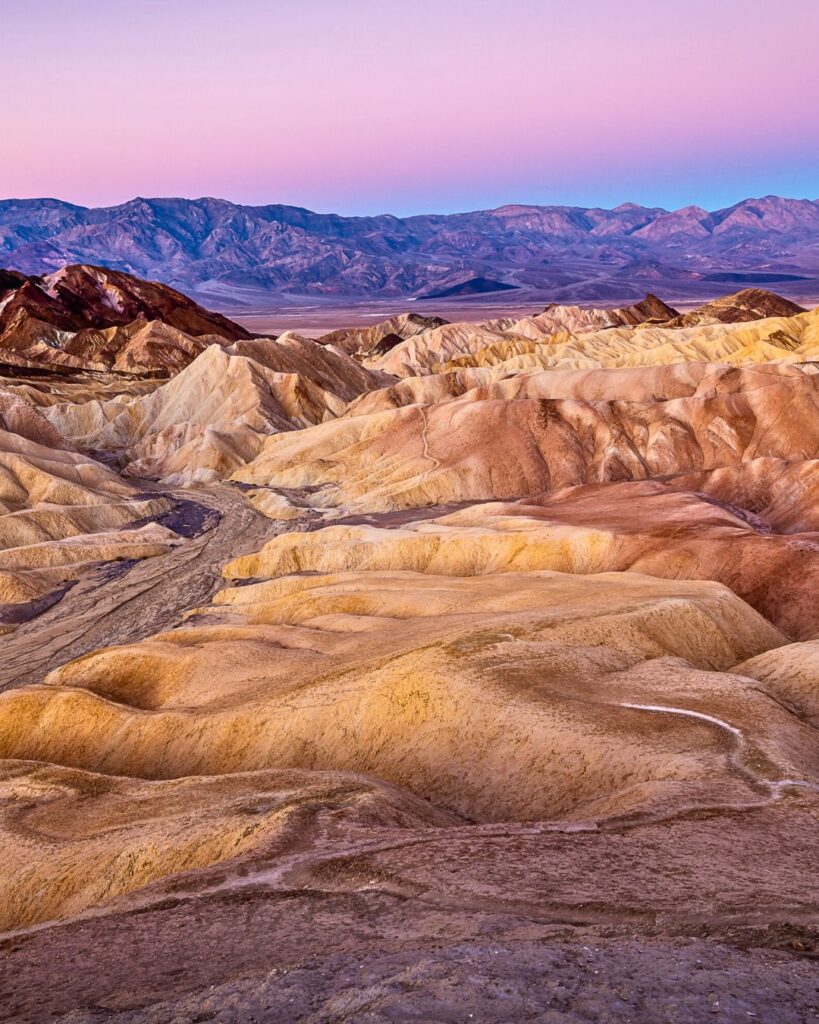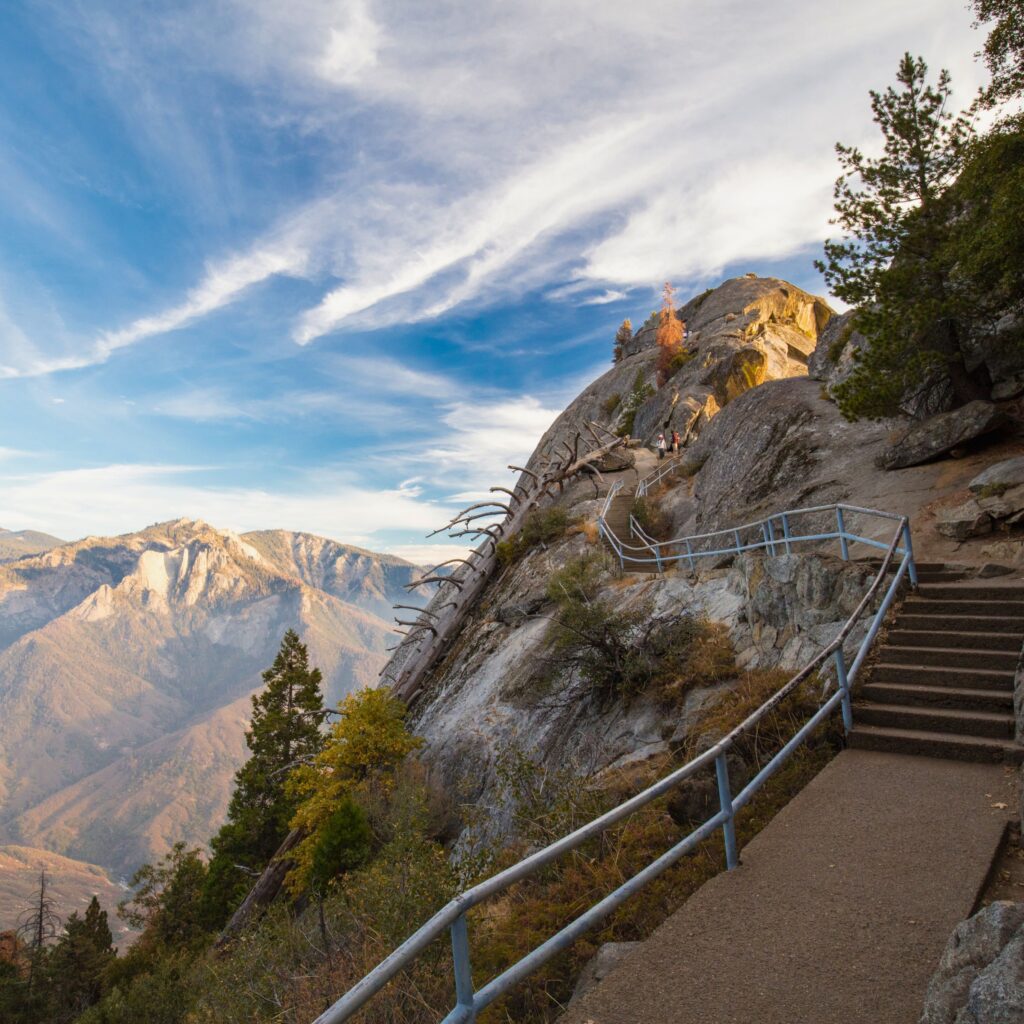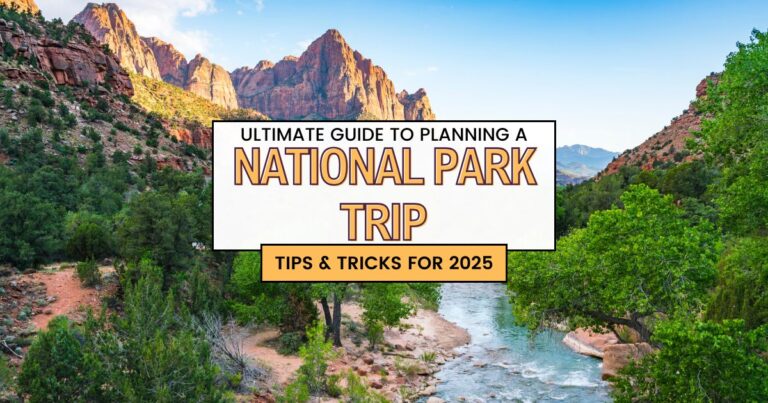If you’re dreaming of your next National Park adventure but overwhelmed by where to start, you’re not alone. After visiting 46 U.S. National Parks, we’ve fine-tuned a system that helps us plan epic, stress-free trips every time. Whether you’re heading out for your first or fiftieth park visit, this guide will walk you through exactly how to plan your National Park trip with confidence. This guide is specific for 2025 National Park trip planning with all of the most up to date information.
This blog post is for anyone looking to make the most of their National Park vacation—especially if you’re focused on budget travel, avoiding crowds, and not missing the must-see spots.
Step 1: Check Permit & Entry Reservation Requirements
Why it matters: Several National Parks now require timed-entry reservations, wilderness permits, or advance parking passes—especially during peak season. If you skip this step, you risk being turned away at the entrance or missing out on key experiences like sunrise at Cadillac Mountain in Acadia or hiking Angels Landing in Zion.
How can you secure permits for a National Park trip?
As part of your 2025 National Park trip planning, it’s important to know which parks require reservations or special permits. Some parks use timed-entry systems or specific hiking permits to help manage crowds and protect resources.
Types of Permits to Watch For:
- Timed Entry Reservations: Required for high-traffic areas (e.g., Arches, Zion).
- Vehicle Reservations: Some parks require reservations to access certain areas, like Glacier’s Going-to-the-Sun Road.
- Hiking Permits: Certain trails, such as Angels Landing in Zion and Half Dome in Yosemite, require permits.
Tips:
- Permit releases are often 6 months out or on a rolling schedule. Mark your calendar for popular permit drops (e.g., Yosemite Half Dome or Glacier’s Going-to-the-Sun Road).
- Make sure you check the park’s specific website and recreation.gov for the most up to date information.
Parks That Require Extra Permits in 2025
- Acadia: Vehicle reservation for Cadillac Summit Road from May 22 through October 27.
- Arches: Timed entry required April 1 to July 6 and August 28 to October 31, 7 am to 4 pm.
- Carlsbad Caverns: Timed entry reservation required year-round for cave entry.
- Glacier: Vehicle reservation required for Going-to-the-Sun Road from June 13 to September 28, 7 am to 3 pm.
- Haleakala: Vehicle reservation required to access the park early enough to watch the sunrise.
- Mount Rainier: NOT ANNOUNCED YET BUT EXCEPT: Timed entry reservation required for Paradise Corridor (May 24 – September 2) and Sunrise Corridor (July 3 – September 2).
- Rocky Mountain: Timed entry required May 23 to October 19, 9 am to 2 pm. Separate timed entry is required for Bear Lake Road, 5 am to 6 pm.
- Shenandoah: Hiking permit required for Old Rag from March 1 to November 30.
- Yosemite: NOT ANNOUNCED YET BUT EXPECT: Timed entry reservation required February 8-9, 15-17, 22-23, and April 13 – October 27; hiking permit required for Half Dome year-round.
- Zion: Hiking permits required for Angels Landing, the Subway, and the Narrows top-down.
- Redwoods: Reservation required for Tall Trees Trailhead year-round and Fern Canyon Trailhead from May 15 to September 15.
Booking Tips:
- All of these reservations/permits can be found on recreation.gov
- Except for Redwood hikes. Please visit Redwood Parks Conservancy for permits.
- Look at each park’s NPS website for more details
Step 2: Research Closures, Weather, and Seasonal Conditions
Why it matters: Trail closures, wildfire damage, snowpack levels, and seasonal flooding can make or break your park experience. What looks accessible on AllTrails might actually be closed or dangerous.
What to look for:
- Seasonal road closures (e.g., Tioga Road in Yosemite)
- Trail conditions and avalanche risks
- Flash flood warnings in desert parks (like Zion or Big Bend)
Helpful tools:
- Park-specific Facebook pages and local ranger updates
- NPS current conditions page
- NOAA.gov for weather forecasts

Mountain Parks (e.g., Glacier, Rocky Mountain National Park):
Expect rapidly changing weather, especially at higher elevations. Be prepared for rain or snow even in summer, and bring layers and waterproof gear. SNOW LINGERS into the summer at parks like Crater Lake, Glacier, Mount Rainier. This snow can delay road openings until mid-July. Please plan your trips accordingly and purchase some microspikes so you can still enjoy the parks if snow is lingering.Desert Parks (e.g., Death Valley, Joshua Tree):
Temperatures can soar, especially in summer months but be cold at night. Plan to hike early or late in the day to avoid the extreme heat. Pack layers to keep warm once the sun goes down.Coastal Parks (e.g., Olympic National Park):
These parks often receive rain, particularly in winter and spring. Waterproof clothing and boots are essential.
Resources to Monitor Weather:
- Check the National Weather Service and NPS weather pages for up-to-date forecasts.
- Apps like AllTrails and MyRadar can provide trail-specific weather information.
Step 3: Book Your Lodging and Travel Early for 2025 National Park Trip Planning
For the most successful 2025 National Park trip planning, secure your accommodations well in advance. National Parks have limited lodging options, and they fill up quickly, particularly during peak season.
Inside vs. Nearby Accommodations:
Staying inside the park offers convenience but can be pricey and hard to book. Nearby towns offer alternatives, often at more affordable rates.
When to book:
- 3–6 months ahead for major parks like Yellowstone, Glacier, and Grand Canyon
- Consider shoulder seasons (May, September) for better deals and fewer crowds
Booking Tips:
- For inside-park accommodations, visit official websites like Xanterra.
- For private stays, try Airbnb or Booking.com in towns like Moab (for Arches) or Gatlinburg (for Great Smoky Mountains).
- Camping: National Parks offer a variety of campgrounds. Book through recreation.gov or the park’s official site.
Budget travel tips:
- Use Google Flights to find the cheapest major airport nearby (e.g., flying into Las Vegas for Zion and Bryce Canyon)
- Book refundable lodging and monitor for price drops
- Consider camping, car camping, or dispersed camping to cut costs
Step 4: Choose Your Must-See Spots & Hikes
Why it matters: Most National Parks are too large to see it all in one visit. Focusing on your top must-do hikes and scenic stops ensures you maximize your time and energy.
How to choose:
- Search Google, Pinterest, and Instagram with hashtags like #GlacierNP or #ArchesHikes
- Use AllTrails to filter by difficulty, distance, and user reviews
- Save your favorites to a custom Google Map
Planning hack: Build in buffer time for spontaneous stops or trail changes due to crowds or weather.
Step 5: Plan Your Route and Timing for 2025 National Park Trip Planning
Planning your route is essential to minimize crowds and make the most of your 2025 National Park trip:

Travel During Shoulder Seasons: If possible, plan your trip during the spring or fall when parks are less crowded.
Visit Popular Sights Early: Get to iconic spots at sunrise to avoid the crowds and enjoy them at their best.
Don’t Over-plan Your Day: Allow extra time for longer drives and unpredictable hike durations to avoid rushing.
Stay Inside the Park: Spend your time within the park as much as possible before leaving for the day to avoid wasting time on the roads.
Step 6: What are the essential items for Visiting a National Park?
Packing the right gear is essential for a successful 2025 National Park trip planning. Depending on the park and the time of year, you’ll need to adjust your packing list.
What to bring:
- Layers: especially for high elevation or shoulder seasons
- Hiking shoes with solid grip
- Sun protection: hat, sunglasses, reef-safe sunscreen
- Reusable water bottle or hydration pack
- Offline maps or GPS (cell service is often nonexistent)
Pro tip: Use packing cubes and check the 10-day forecast before you leave.
Weather-Specific Gear:
- Waterproof gear for rainy parks like Olympic and Great Smoky Mountains.
- Layered clothing for cooler mountain parks like Rocky Mountain or Glacier.
Hiking Essentials:
Bring sturdy hiking boots, a first-aid kit, trekking poles, trail maps, sunscreen, and extra water.
Emergency Preparedness:
For remote parks, consider carrying a satellite phone or personal locator beacon.
Step 8: Take Advantage of National Park Free Entrance Days in 2025
2025 National Park trip planning becomes more affordable with free entrance days, when you can visit most parks without paying the usual entrance fee.
2025 Free Entrance Days:
- January 20: Martin Luther King Jr. Day
- April 19: First Day of National Park Week
- June 19: Juneteenth National Independence Day
- August 4: Great American Outdoors Act Signing Day
- September 27: National Public Lands Day
- November 11: Veterans Day
Top Parks to Visit on These Dates:
- January 20: Everglades, Saguaro, or Death Valley for unique experiences.
- April 19: Great Smoky Mountains, Zion, and Arches for spring hikes.
Step 9: Be Aware of Construction and Closures in 2025 National Park Trip Planning
A few parks will experience significant construction projects that may impact your 2025 National Park trip planning. These projects can lead to longer delays, road closures, or the unavailability of certain areas.
Parks with Major Construction in 2025:

- Mount Rainier: Major construction projects at campgrounds and along State Route 123 from April to October. Expect delays and possible campground closures.
- Big Bend: The Chisos Basin area will be closed indefinitely starting May 1, 2025. This area includes key amenities and trailheads, so be sure to check before your trip.
- Yellowstone: Multiple construction projects are ongoing as part of a major overhaul. Check the park’s construction map for updates and to avoid traffic.
- Glacier: Going-to-the-Sun Road is scheduled to be fully open, but the Swiftcurrent area will be closed in 2025. Parking will be more crowded, and some trailheads may be unavailable.
Check for Ongoing Projects:
Always check the NPS construction updates before you go to make sure nothing unexpected interferes with your plans.
2025 National Park Trip Planning Bonus Tips
- Download offline maps: Google Maps and Gaia GPS
- Use the official NPS app: Many parks now have trail maps, alerts, and visitor center hours
- Prep for car time: Some parks involve long drives—download podcasts, audiobooks, or your favorite playlists
- Know the rules: Check pet policies, drone restrictions, and off-trail hiking guidelines
- Leave No Trace: Respect the land and pack out all trash
Get Ready for Your 2025 National Park Adventure
With a little planning, your 2025 National Park trip can be a smooth and unforgettable experience. From picking the right time to visit and getting permits to avoiding crowds and navigating construction, being prepared will help you make the most of your time in the parks. Be sure to plan your route, visit popular sights early, and leave some flexibility in your schedule. And if possible, aim for the quieter shoulder seasons for a more peaceful trip.
Enjoy the journey, and check out my other posts for more tips on avoiding crowds and finding the best times to visit!

